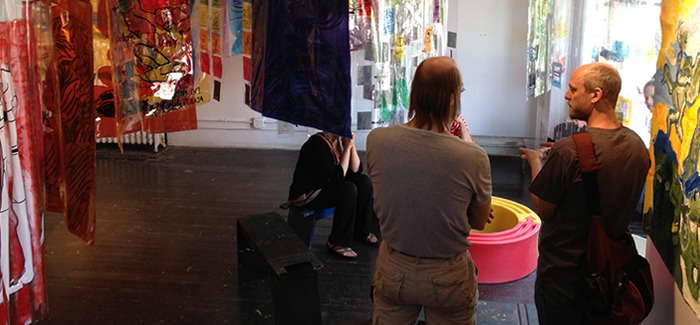
(Photography by Derek Tsang, ’15)
Touring community arts centers in Woodlawn.
Bronzeville’s South Side Community Arts Center (SSCAC) looks its age, for good and for ill, weathered inside and out by decades of use and reuse. Stashed up on its second floor, in a collision of modern and historic sensibilities, is eccentric Englewood artist Andrius Kulikauskas’s latest exhibit, Think Through. It’s a multicolored maze of primitive hieroglyphs, religious symbolism, and philosophical maxims; he calls it a “transparent labyrinth.”
On a recent Monday morning, this curious coupling of Kulikauskas’s childlike art—made from ribbons of plastic vinyl, cardboard, and markers—and the SSCAC’s dignified bearing forms the backdrop for the Woodlawn/SHoP workshop. The series is cosponsored by the Graham School and the Civic Knowledge Project, the Humanities Division’s community outreach arm.
After a monthlong survey of the South Side’s ecosystem of community and art centers, the workshop’s curator, artist John Preus, MFA’05, is taking his class into the field for another six weeks to better understand Woodlawn’s history and power dynamics. Kulikauskas is showing his exhibit to his classmates as a concrete example of how art inhabits space, and how artists interact with organizers.
The rest of the class members are similarly active on the South Side, as organizers and artists. Laura Shaeffer is Preus’s partner at the Southside Hub of Production (SHoP), which has been using Fenn House, an 1890s mansion on Woodlawn Avenue, as a center for social and artistic programming since 2011. Grace and Nia are Graham School students looking to better understand arts organizing; Grace says she’s more interested in the “business end of things,” while Nia, a writer, says she’s learning more through the class about Woodlawn’s art scene than she has as a frequent volunteer and participant.
[[{"type":"media","view_mode":"media_original","fid":"812","attributes":{"alt":"","class":"media-image","height":"588","typeof":"foaf:Image","width":"460"}}]]
So here we are: real-world U, week three. Preus has scheduled us a tour at the Swift Mansion—formerly a dowry, a morgue, and a political headquarters, and now a transition house—and then it’s off to the nearby SSCAC. The class is intimate, casual, and even improvised: Danielle, who takes us in and around the Swift Mansion, comes along impromptu to the SSCAC; two other organizers passing through latch on to the group; car rides are offered freely; and everybody seems to have met, collaborated with, or heard about everyone else.
The Swift Mansion, like the SSCAC, sags with history. We’re hushed as we walk through the hallways wallpapered with bright posters, but upon surfacing, the group is buzzing about the potential of the space and its abundant windows. Danielle draws our attention to the “natural light,” and Kulikauskas coos about a third-floor room’s “inspiring vantage.”
Preus zeroes in on the relationship between a space and its community. “We’re thinking about how a space is local and broader,” he says. “If it’s too local, the only audience is your neighbors, but you also want locals to be induced to walk in and feel like they belong.”
It’s not just a theoretical concern. The First Unitarian Church decided not to renew SHoP’s lease at Fenn House for 2013, so SHoP is homeless for the time being. Preus and Shaeffer are scoping out potential sites, like the Swift Mansion, but Shaeffer isn’t sure they even need a building at all. “I’m really captured by the idea of an outdoor space,” she says, “although that could just be because it’s nice outside.”
A few blocks away, after digesting Kulikauskas’s exhibit, the discussion resumes, with SSCAC’s new executive director Heather Robinson chiming in. Comparing the SSCAC to UChicago’s new Logan Center for the Arts and the DuSable Museum of African American History, Robinson isolates why the SSCAC’s “vibe” is unique. “We’re art,” she says, “but we’re also history. And nobody else [on the South Side] can say that.”
The SSCAC, though, isn’t the only mouthpiece for the South Side’s community members and artists. In past weeks, the group has visited Experimental Station and the Woodlawn Collaborative, each of which go about encouraging artists in their own way.
The broadest take on community art perhaps comes from the Civic Knowledge Project’s director—philosophy prof and student favorite Bart Schultz, PhD’87. He’s well versed in the history of the South Side, and part of the Civic Knowledge Project’s mission is to help overcome social divisions with programs like Woodlawn/SHoP that connect different communities. He points to UChicago as a crucial potential resource, and Schultz doesn’t see the University’s historically checkered relationship with the rest of the South Side as discordant with community outreach. Part of the University’s character, he contends, is how it contains completely different spheres. “We like to deal with what doesn’t get a lot of notoriety,” says Schultz. “Sometimes, they’re just as important as the big things.”
